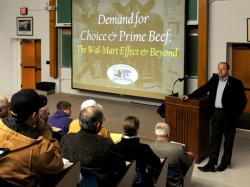Responding To Demand
March 20, 2012 | 3 min to read

Charting a course in the beef industry means acting on market signals and being ready for the reactions to those actions.
“The message of consumer demand is more complicated than it has ever been,” John Stika said at the Kansas State University Cattlemen’s Day earlier this month. Regardless of position in the beef industry, “we must interpret and respond by balancing those needs and expectations of consumers with our need to make a profit.”
The president of Certified Angus Beef LLC (CAB) said that response is critical at every step from the cow-calf to retail level. “Being the closest to the consumer, retailers are the first to detect these changing preferences,” he said.
Trend lines in 2011 clearly show a retail shift toward higher quality beef, with many of the largest companies making room for Choice product in their meat cases.
“Wal-Mart didn’t create a quality demand move,” Stika said. “They responded to it.” Consumers today consider a price-value relationship rather than price alone.
“We as an industry have experienced record sales of premium Choice beef during the worst economy in recent years,” he noted. “The only way to explain this is that folks were careful where their dollars were spent, and they didn’t gamble in the meat case.”
So consumers are willing to pay more for a product that they know is worth more (see chart), and they may be willing to pay still more.
“But there is an end out there somewhere,” Stika said. “For consumers to accept higher prices, we as producers must continue to increase quality.”
That way, retailers who have responded by offering more high-quality beef will be able to maintain that strategy and satisfy consumers who want their money’s worth.
The response must come from an entire industry that focuses on taste, the top reason consumers buy beef, said Stika, who admitted it seems a distant goal for many producers.
“Eating satisfaction is a lower priority and a challenge to focus on,” he said. “That’s because there are so many other factors weighing into their decisions. But producers must hedge those factors against long-term beef demand.”
Stika acknowledged the real need for increasing efficiency amid high input costs, but progress there would ring hollow if the source of demand walks away. “We must always consider the wants and expectations of the consumer, who brings the only sustainable flow of dollars into our businesses.”
Source: Certified Angus Beef Brand
